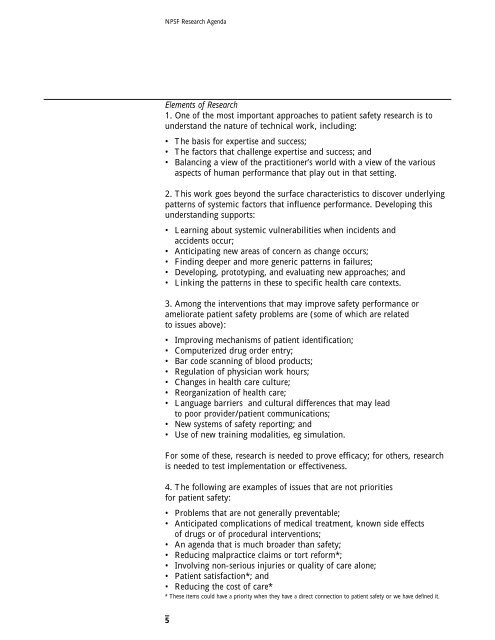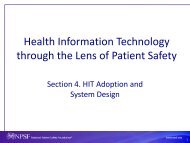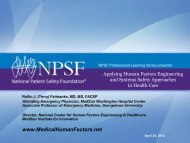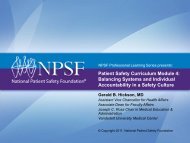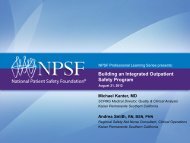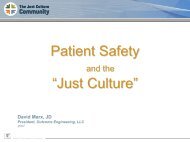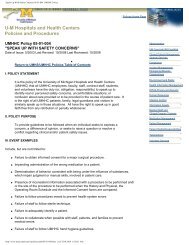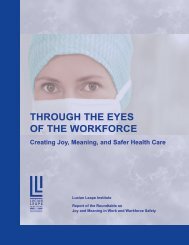Agenda for Research and Development in Patient Safety
Agenda for Research and Development in Patient Safety
Agenda for Research and Development in Patient Safety
- No tags were found...
Create successful ePaper yourself
Turn your PDF publications into a flip-book with our unique Google optimized e-Paper software.
NPSF <strong>Research</strong> <strong>Agenda</strong>Elements of <strong>Research</strong>1. One of the most important approaches to patient safety research is tounderst<strong>and</strong> the nature of technical work, <strong>in</strong>clud<strong>in</strong>g:• The basis <strong>for</strong> expertise <strong>and</strong> success;• The factors that challenge expertise <strong>and</strong> success; <strong>and</strong>• Balanc<strong>in</strong>g a view of the practitioner’s world with a view of the variousaspects of human per<strong>for</strong>mance that play out <strong>in</strong> that sett<strong>in</strong>g.2. This work goes beyond the surface characteristics to discover underly<strong>in</strong>gpatterns of systemic factors that <strong>in</strong>fluence per<strong>for</strong>mance. Develop<strong>in</strong>g thisunderst<strong>and</strong><strong>in</strong>g supports:• Learn<strong>in</strong>g about systemic vulnerabilities when <strong>in</strong>cidents <strong>and</strong>accidents occur;• Anticipat<strong>in</strong>g new areas of concern as change occurs;• F<strong>in</strong>d<strong>in</strong>g deeper <strong>and</strong> more generic patterns <strong>in</strong> failures;• Develop<strong>in</strong>g, prototyp<strong>in</strong>g, <strong>and</strong> evaluat<strong>in</strong>g new approaches; <strong>and</strong>• L<strong>in</strong>k<strong>in</strong>g the patterns <strong>in</strong> these to specific health care contexts.3. Among the <strong>in</strong>terventions that may improve safety per<strong>for</strong>mance orameliorate patient safety problems are (some of which are relatedto issues above):• Improv<strong>in</strong>g mechanisms of patient identification;• Computerized drug order entry;• Bar code scann<strong>in</strong>g of blood products;• Regulation of physician work hours;• Changes <strong>in</strong> health care culture;• Reorganization of health care;• Language barriers <strong>and</strong> cultural differences that may leadto poor provider/patient communications;• New systems of safety report<strong>in</strong>g; <strong>and</strong>• Use of new tra<strong>in</strong><strong>in</strong>g modalities, eg simulation.For some of these, research is needed to prove efficacy; <strong>for</strong> others, researchis needed to test implementation or effectiveness.4. The follow<strong>in</strong>g are examples of issues that are not priorities<strong>for</strong> patient safety:• Problems that are not generally preventable;• Anticipated complications of medical treatment, known side effectsof drugs or of procedural <strong>in</strong>terventions;• An agenda that is much broader than safety;• Reduc<strong>in</strong>g malpractice claims or tort re<strong>for</strong>m*;• Involv<strong>in</strong>g non-serious <strong>in</strong>juries or quality of care alone;• <strong>Patient</strong> satisfaction*; <strong>and</strong>• Reduc<strong>in</strong>g the cost of care** These items could have a priority when they have a direct connection to patient safety or we have def<strong>in</strong>ed it.5


